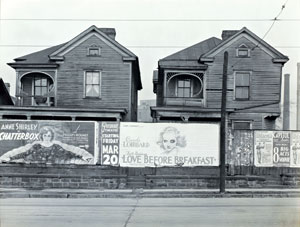Walker Evans‘ indelible photos of the Depression have acquired a nostalgia factor, a cruel thing to happen to work made in protest.
Today, the pictures of pine-walled cabins and farmers of seemingly untouchable integrity hit you like a Johnny Cash song. The fascination has to be something more than a longing for purity, orderliness and hand-made objects.
The Cantor Arts Center‘s new show of 100-plus photos from the Fisher Collection is priced for the New Depression: absolutely free. And we see there was more to Walker than just his images of the 1930s.
Evans was from St. Louis. He went to Paris in the 1920s to write, drawn by the realists and the poets alike. In France, Evans switched mediums.
An early photo shows the funnel shape of the looming Brooklyn Bridge, as seen from its underside. The image illustrates Hart Crane’s poem; they were published by the decadent Harry Crosby’s Black Sun Press.
Years later, in 1962, Evans took a picture of a heavy New York manhole cover encrusted with litter and cigarette butts—a sight, Evans wrote, that he wished Baudelaire could have seen.
Maybe Evans anticipates the Manhattan spleen of the photographer Weegee in his pictures of mean, exhausted or suspicious faces. Evans was a spy in the cities, everywhere from Chicago to the Havana markets.
Evans is internationally remembered for the photos he took to accompany author/film critic James Agee’s survey of three sharecropping families, Let Us Now Praise Famous Men.
We see inside the farmer’s shacks, and they’re clean and poor and simple. So clean, Agee enthused, you couldn’t lick them cleaner. It’s not quite that simple upon a closer viewing.
Sometimes, the pieces of cardboard glued up to keep the cold wind out are salvaged from advertising signs and pieces of billboards, one of Evans’ obsessions. Glossy figures give the rooms a touch of the fantastic, just as the odd angles and crevices of the slapped-together walls keep these rooms from prettified starkness.
The faces of the farmers are complex. Evans’ 1936 portrait of the thin-lipped and formidable Allie Mae Burroughs has the flatness of a Tudor portrait. As in Holbein’s pictures of royals, the plainness is a kind of power in itself.
The somnolence of the South drew Evans again and again. A grand old plantation-era building is hung with banners—and has become a car-parts warehouse. The rising damp flecks the walls of an empty riverside mansion.
We see the brickwork of dozing downtown Selma, Ala., a town 30 years away from its date with civil-rights history. Black folk at a barbershop rest on benches in front of a row of off-plumb plank buildings.
Evans’ 1930s work predicts how we’ll remember the Depression. Here we see the oft-anthologized photo of a billboard of Carole Lombard, beautifully coiffed but with a big black eye promoting the 1936 film Love Before Breakfast. The streetcar-size ad is plastered on a fence in front of a pair of shabby unpainted houses in Atlanta. Welcome to Potemkinville.
The aftermath of such images also excited Evans—showbiz after the rain. Weathered posters shed their paper like eucalyptus bark. It’s the age-old contrast of the rough with the smooth, the mixed-message of things for sale that can’t be bought because they’re gone.
Evans’ photos done for the Resettlement Administration show the quality of art that can be had by spending a little government money. Still, Evans also worked for Fortune and other Luce magazines. He did still lifes of chrome tools; they are lustrous, slightly threatening, but absolutely functional as advertising.
Evans’ pictures of soon-to-be-demolished buildings could, to the businessman’s mind, look like a celebration of progress. In the 1950s, he surveyed the worn heraldry on the sides of railroad boxcars; the caption on one reads, “Before They Disappear.”
If Evans’ work is greatly accessible, he also had the eye able to make art with the handy and inexpensive Polaroid camera. His 1970s work anticipates Basquiat: squares of graffiti and dripping, hand-painted warning signs.
We see the man himself last, in D. Kent’s Polaroid portrait, taken the year before Evans died, with a Rembrandt frown and a huge Santa Claus beard. Weary, but still the real thing.
Walker Evans Photographs
Runs Through April 8



